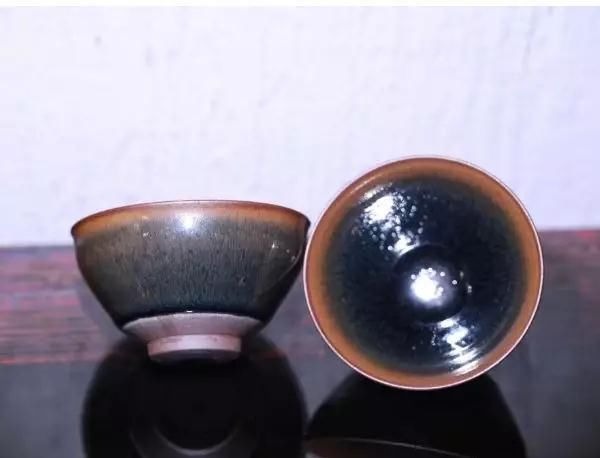Difference and value of wood-fired vs electric-fired Jianzhan teacups.
Jianzhan teacups are fired with a single color but come out of the kiln with a thousand hues. This is the greatest charm of wood-fired Jianzhan, as well as a manifestation of its difficulty to fire. In the same kiln, the glaze colors of Jianzhan vary greatly, even for those placed in the same box or bowl.
If a wood-fired Jianzhan and an electric-fired Jianzhan have the same pattern effect, the wood-fired one would be preferred. Both types of Jianzhan use exactly the same raw materials, but differ in the way they are heated and the kiln environment. Wood-fired Jianzhan has a smoother glaze due to the warmer temperature of the kiln.

The craft principle of Jianzhan is unique, and the formation of its patterns requires extremely high precision in terms of time and temperature. Once outside of this narrow range, the patterns will disappear forever. Both electric and wood-fired Jianzhan face this technical challenge, but electric firing allows for better control over the firing process and can produce effects that are difficult to achieve with wood-firing. In terms of pattern effects, electric-fired Jianzhan has made significant progress and solved many of the technical bottlenecks of wood-firing, which has allowed the industry to form and develop. In turn, this industry development can help promote the wood-firing process, but at present, there have not been many achievements in wood-firing.

In ancient times, Jianzhan was fired using the wood-firing process. In modern times, with the invention of electricity, electric-fired Jianzhan emerged. So, what are the differences between traditional wood-firing and modern firing techniques (electric, gas, coal, etc.)?
To summarize briefly, there are several differences between wood-firing and modern firing techniques. Firstly, because wood-firing requires continually adding wood during the firing process, the temperature fluctuates, resulting in uneven bubble sizes and a certain sense of hierarchy in the glaze. In contrast, modern gas and electric firing techniques produce even and dense bubble sizes.
Secondly, because the temperature in wood-fired kilns is difficult to control and varies, it results in the color of Jianzhan being difficult to control and exhibiting a deep and light effect. In contrast, gas kilns can maintain a constant temperature, resulting in more stable colors.
Thirdly, wood-fired kilns produce ashes and flames that easily enter the kiln and settle naturally on the body of the Jianzhan. With prolonged high-temperature fusion with the glaze, this creates a warm and layered color.
Of course, the above methods are only one way to distinguish between different firing techniques, and modern firing techniques can also replicate the effects of wood-firing. Therefore, the above information should only be used as a reference.
Some Jianzhan enthusiasts have asked, "Why are wood-fired Jianzhan teacups so expensive?"
Wood-fired Jianzhan teacups are expensive because there are many constraints to firing them in a wood kiln. Firstly, the government strictly prohibits wood-firing except under special approval in order to protect forest resources. Additionally, there are high requirements in terms of both funding and technology, which means that it is not something that anyone can do by simply building a stove and firing porcelain with a few pieces of wood.
Wood-firing is also an ancient firing method that uses wood as fuel. In ancient times, firing porcelain in a wood kiln required covering the porcelain body and isolating the wood ash from the glaze surface to prevent ash falling on the glaze or leaving fire marks. In modern ceramic production, firing techniques have matured, and modern aesthetics are vastly different from those of ancient times. Modern wood-firing pursues the natural combination of wood ash and clay.

Kiln masters cannot predict the outcome of a kiln firing, but one thing is certain: each porcelain piece that comes out of the firing is unique.
Wood-firing is a direct dialogue between the kiln master and the kiln, using the most primitive method to create amazing works of art. The fired ceramic products display yin-yang changes between the fired and unfired sides, as well as the marks left by the flames. They emit a simple, profound, and antique beauty that is the reason why wood-firing ceramic artists are so fascinated with it and put in a lot of effort to pursue it.






